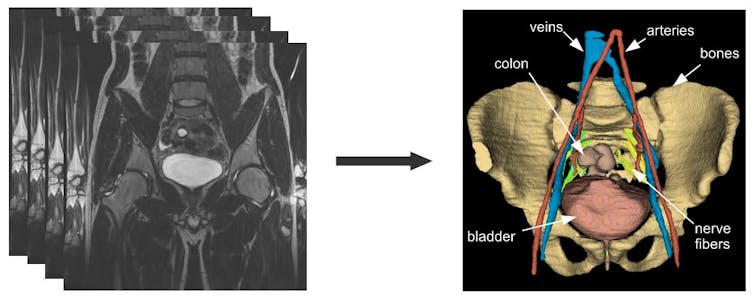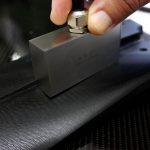MT 180: 3D organ models facilitate surgery on children
Alessio Virzì, Biomedical Engineer – PhD student in Medical Image Processing, Télécom ParisTech – Institut Mines-Télécom, Université Paris-Saclay
The original version of this article (in French) was published on The Conversation, in connection with Alessio Virzì’s participation in the competition “My thesis in 180 seconds”.
[divider style=”normal” top=”20″ bottom=”20″]
What area have you chosen to focus on for your thesis?
I am interested in developing new tools for processing medical images for pediatric minimally invasive pelvic surgery.
This type of surgery involves a technique in which small incisions are made to enable the surgeon to reach the target area while limiting surgical trauma as much as possible. The technique involves robotic tools and a video imaging system that helps guide the surgeon’s movements. Due to the anatomical complexity of a child’s pelvis, the surgical planning stage, based on the study of medical imaging, is a crucial step.
What will your thesis work contribute to this area?
My thesis proposes new methods for processing medical images adapted to children with pelvic tumors or malformations. I am developing IT solutions for generating virtual 3D models of organs, tumors and nerve fibers based on MRI images.
Surgeons can view these 3D models before and during the surgery, thus improving the way they plan for the operation and providing more information than a simple video imaging system.
For example, I used artificial intelligence to analyze the pixels in the images to detect the different anatomical structures. I also used generic models of organs that I then adapted to the child to obtain the final 3D model.
I integrate all of these IT methodologies into interactive software that makes the surgeon the main actor in the image analysis process. In addition, thanks to this software, surgeons can easily verify the quality of the 3D models obtained and can make corrections as needed, based on their anatomical knowledge.
I developed this software based on existing open-source software that I improved by integrating specific models for MRI images of children’s pelvises.
It was very important for me to offer a tool that could easily be used in a clinical context by surgeons who are not specialized in computer science.
What challenges have you faced along the way?
The first challenge was the limited amount of scientific literature on this topic, since this research area is underexplored. I therefore had to base my work on medical imaging studies on other anatomical structures like the adult brain.
Another major challenge was the need to develop methods that could be used in clinical practice. They needed to be extremely effective and easy for surgeons to use. This required additional efforts in the design and development of the software.
My communication with surgeons and radiologists played a crucial role in developing my research and allowed me to discover anatomical knowledge that I had not necessarily been aware of before and helped me understand their requirements for IT tools.
When did you decide to start a thesis?
My desire to do a thesis first arose during a research internship I did for my Masters 2 studies in biomedical engineering, that provided an opportunity to work on new applications in neuro-imaging.
In the future, I would like to continue working in the medical field because I find this area very motivating. My desire to find new applications has led me to explore the possibility of working in medical imaging in the private sector.
What are your thoughts on “My Thesis in 180 Seconds”?
I think the ability to share scientific knowledge is a key skill for researchers.
Unfortunately, I believe this aspect is not sufficiently present in scientific training. As researchers, we often have the unfortunate habit of using terms that are too specific and not accessible for non-scientists. Yet it is essential for us to help everyone understand what we are doing, both to demonstrate the importance of our work and stimulate its development.
This experience will definitely help me improve my skills in popularizing scientific knowledge and help me become more comfortable presenting this information to the public. It is also a very motivating challenge to have to present my thesis in a language that is not my first language and that I began using three years ago when I arrived here from Italy.





Leave a Reply
Want to join the discussion?Feel free to contribute!